
Tucson is a city in and the county seat of Pima County, Arizona, United States, and is home to the University of Arizona. It is the second-largest city in Arizona behind Phoenix, with a population of 542,629 in the 2020 United States census, while the population of the entire Tucson metropolitan statistical area (MSA) is 1,043,433. The Tucson MSA forms part of the larger Tucson-Nogales combined statistical area. Both Tucson and Phoenix anchor the Arizona Sun Corridor. The city is 108 miles (174 km) southeast of Phoenix and 60 mi (97 km) north of the United States–Mexico border. Tucson is the 34th-largest city and the 53rd-largest metropolitan area in the United States (2014).
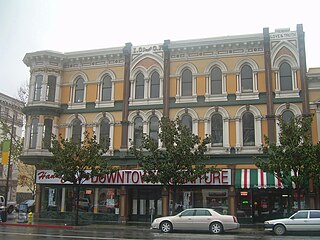
The Downtown Historic District of San Jose, California is a designated U.S. Historic District area of the city roughly the size of one square block. It is bounded by S. First Street to the west, E. San Fernando Street to the south, S. Third Street to the east, and E. Santa Clara Street to the north, but also includes the south side of E. Santa Clara Street between Third and Fourth Streets.

The Drake Court Apartments and the Dartmore Apartments Historic District, built between 1916 and 1921, is located at Jones Street from 20th to 23rd Streets in Midtown Omaha, in the U.S. state of Nebraska. Built in combined Georgian Revival, Colonial Revival and Prairie School styles, the complex was designated a City of Omaha Landmark in 1978; it was listed on the National Register of Historic Places as a historic district in 1980. The historic district originally included 6.5 acres (2.6 ha) with 19 buildings. In 2014, boundary of the historic district was expanded by 0.74 acres (0.30 ha) include three additional buildings, and decreased by 3 acres (1.2 ha) to remove open space and parking that had been re-purposed, for a new total of 4.24 acres (1.72 ha). The district was also renamed to Drake Court Historic District.
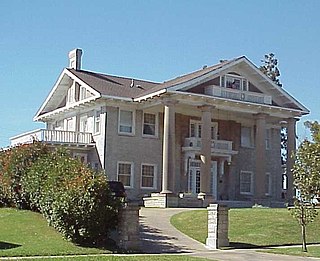
Brady Heights is a historic district in Tulsa, Oklahoma that was listed on the U.S. National Register of Historic Places in 1980, as Brady Heights Historic District. It was Tulsa's first district to be listed in the Register. According to the NRHP documentation, it is the most complete pre-1920 neighborhood surviving in Tulsa. Its boundaries are Marshall Street to the north, the alley between Cheyenne Avenue and Main Street on the east, Fairview Street on the south, and the Osage Expressway right-of-way on the west. At listing, it included 250 contributing buildings.
Josias Thomas Joesler was a Swiss-American Tucson, Arizona architect.

The Barrio de Analco Historic District is a National Historic Landmark District centered at the junction of East De Vargas Street and Old Santa Fe Trail in Santa Fe, New Mexico. The seven buildings of the district represent one of the oldest clusters of what were basically working-class or lower-class residences in North America, and are in a cross-section of pre-statehood architectural styles. It includes two of the oldest colonial-era buildings in the southwest, the San Miguel Mission church (1710), and the "Oldest House", built in 1620 and now a museum. The district was declared a National Historic Landmark in 1968.
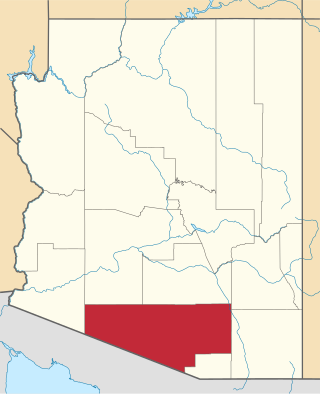
This is a list of the National Register of Historic Places listings in Pima County, Arizona.
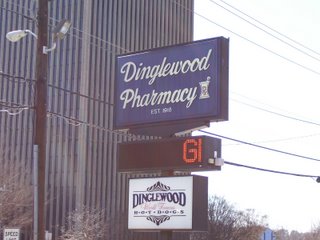
Dinglewood is a neighborhood/subdistrict located at the southern edge of Midtown Columbus, Georgia. In it is the tallest building in Columbus, the Aflac Tower. It is also home to the famous Dinglewood Pharmacy, which serves, in the opinions of the city's residents, the city's best scrambled hot dog. The boundaries of the neighborhood are generally acknowledged to be 17th Street to the north, Martin Luther King Jr. Boulevard to the south, Interstate 185 to the east and Veterans Parkway to the west. In 2007, the estimated population of the area was 1,101.

There are 75 properties listed on the National Register of Historic Places in Albany, New York, United States. Six are additionally designated as National Historic Landmarks (NHLs), the most of any city in the state after New York City. Another 14 are historic districts, for which 20 of the listings are also contributing properties. Two properties, both buildings, that had been listed in the past but have since been demolished have been delisted; one building that is also no longer extant remains listed.

Linden–South Historic District is a national historic district located in the South Wedge neighborhood of Rochester in Monroe County, New York. The district consists of 136 contributing buildings, including 82 residential buildings, 53 outbuildings, and one church. The houses were constructed between 1872 and 1913 in a variety of vernacular interpretations of popular architectural styles including Gothic Revival, Italianate, Queen Anne, and Colonial Revival styles. The houses are 2 1/2-stories, are of frame or brick construction, and were designed by local architects employed by the developer Ellwanger & Barry. Among the more prominent are Andrew Jackson Warner and Claude Bragdon. The church is the former South Avenue Baptist Church, now Holy Spirit Greek Orthodox Church, built in 1909–1910 in a Late Gothic Revival style. Also in the district is a three-story, Queen Anne style mixed use building, with commercial space on the first floor and residential units above, located at 785 South Avenue.

Highland Park–Overlee Knolls, also known as Fostoria, is a national historic district located in Arlington County, Virginia. It is directly east of the Virginia Heights Historic District. It contains 681 contributing buildings, 3 contributing sites, and 1 contributing structure in a residential neighborhood in North Arlington. The first subdivision was platted in 1890 and known as Fostoria.
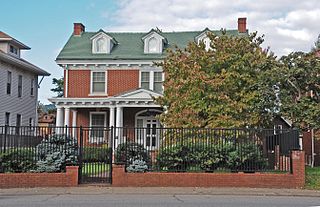
Luna Park Historic District is a federally designated national historic district located in the West Side neighborhood of Charleston, Kanawha County, West Virginia. It encompasses 444 contributing buildings in a predominantly residential section of Charleston. The majority of the homes in the district were constructed in the mid to late 1925s and early 1930s and a portion of the district was the location of a local amusement park, Luna Park, from 1912 until 1923. The houses reflect a variety of popular architectural styles including American Foursquare, American Craftsman / Bungalow, Tudor Revival, and Colonial Revival, including Dutch Colonial Revival.
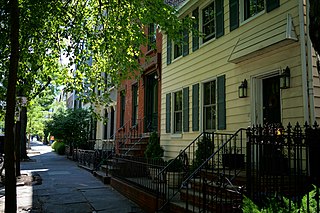
Wallabout Historic District is a national historic district located in the Wallabout neighborhood of Brooklyn, Kings County, New York. The district encompasses 203 contributing buildings in a mixed residential and commercial / industrial section of Brooklyn. The district features noteworthy examples of Greek Revival, Gothic Revival, Italianate, Second Empire, Queen Anne, Beaux-Arts, and Colonial Revival style architecture. It largely developed between about 1830 and 1880, with some later development. It includes vernacular wood houses, masonry single-family rowhouses in brick and brownstone, and multi-family tenements and flat houses.

Crown Heights North Historic District is a national historic district located in the Crown Heights neighborhood of Brooklyn, Kings County, New York. The district encompasses 1,019 contributing buildings in a predominantly residential section of Brooklyn. The district features noteworthy examples of Greek Revival, Gothic Revival, Italianate, Second Empire, Queen Anne, Romanesque Revival, Renaissance Revival, Beaux-Arts, and Colonial Revival style architecture. It largely developed between about 1853 and 1942, and consists of densely constructed rowhouses, townhouses, two-family houses, semi-attached houses, freestanding houses, flats, apartment buildings, and institutional and commercial buildings.

Irvington Terrace Historic District is a national historic district located at Indianapolis, Indiana. It encompasses 578 contributing buildings and 9 contributing sites in a planned residential section of Indianapolis. The district developed between about 1895 and 1959, and includes representative examples of Tudor Revival, Colonial Revival, and Bungalow / American Craftsman style residential architecture.

Watson Park Historic District, also known as Watson Road Historic District and Watson McCord Neighborhood, is a national historic district located at Indianapolis, Indiana. The district encompasses 402 contributing buildings and 4 contributing sites in a predominantly residential section of Indianapolis. They include 255 houses, 27 multiple family dwellings, and 120 garages. It was developed between about 1910 and 1960, and includes representative examples of Colonial Revival, Tudor Revival, and Bungalow / American Craftsman style architecture. Located in the district is the Watson Park Bird Sanctuary.

Courthouse–Seminary Neighborhood Historic District is a national historic district located at Cape Girardeau, Cape Girardeau County, Missouri. The district encompasses 121 contributing buildings and 2 contributing sites in a predominantly residential section of Cape Girardeau. It developed between about 1848 and 1948, and includes representative examples of Italianate, Queen Anne, Colonial Revival, Tudor Revival, Mission Revival, Late Gothic Revival, American Craftsman, and Art Deco style architecture. The district contains 1 1/2 and 2 1/2-story brick single-family homes, with multi-family homes and a few commercial buildings dispersed throughout. Located in the district is the separately listed Robert Felix and Elma Taylor Wichterich House, William Henry and Lilla Luce Harrison House, Huhn-Harrison House, B'Nai Israel Synagogue, St. Vincent de Paul Catholic Church, August and Amalia Shivelbine House, Glenn House, House at 323 Themis Street, and George Boardman Clark House.

The Barrio El Membrillo Historic District in Tucson, Arizona was listed on the National Register of Historic Places in 2009. The district reflects "Sonoran Tradition", and includes 11 contributing buildings and two non-contributing ones on 4 acres (1.6 ha). It is bounded by W. Granada St. on the north, W. Simpson St. on the south, and the right-of-way of the former El Paso & Southwestern (EP&SW) railroad on the east.

Las Saetas is one of the great examples of Pueblo Revival architecture in the American Southwest. Rebuilt in 1935 from the ruins of the 1873 Post Traders Store the design-build project was led by Dutch-born artist Charles Bolsius, with Nan and Pete Bolsius. The project included hand-carved doors, exposed beams, carved corbels, adobe fireplaces, hand-hammered tin, and a heightened sense of romanticism. The property and its transformation over a 150-year-span reflect the changing culture and economic milieu of Southern Arizona and the American West.























